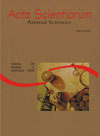<b>Apparent digestibility of diets containing sugar cane silage treatedwith chemical or microbial additives fed to lambs</b> - DOI: 10.4025/actascianimsci.v29i1.260
Abstract
Ensiling of sugar cane maycontribute to improve operational efficiency at farm level. However, the high ethanol levelfound in sugar cane ensiled without additive may reduce voluntary feed intake and mayaffect animal performance. This experiment was performed to evaluate the effects of freshsugar cane and sugar cane silage treated with microbial (Lactobacillus buchneri) or chemical(urea) additives on apparent digestibility of diets fed to lambs. Twelve Santa Inês lambs (49 ± 3 kg) were assigned to a complete randomized block design and fed a 50:50 (concentrate:roughage ratio) TMR. Experimental treatments were the roughage source: fresh sugar cane(FSC), sugar cane silage with L. buchneri (SCS + Lb), sugar cane silage with 1% urea (SCS1%) or sugar cane silage with 1.5% urea (SCS1.5%). NDF digestibility coefficient waslower (p<0.05) for SCS compared to sugar cane silages (FSC vs SCS + Lb; FSC vs SCS1% and SCS1.5%). CP digestibility was higher (p<0.05) for animals fed SCS1.0% comparedwith those fed SCS1.5%. There were no differences (p>0.05) in nitrogen balance for all thecomparisons evaluated. The sugar cane ensiled improve NDF digestibility.Downloads
Download data is not yet available.
Published
2007-11-13
How to Cite
Gentil, R. S., Pires, A. V., Susin, I., Nussio, L. G., Mendes, C. Q., & Mourão, G. B. (2007). <b>Apparent digestibility of diets containing sugar cane silage treatedwith chemical or microbial additives fed to lambs</b> - DOI: 10.4025/actascianimsci.v29i1.260. Acta Scientiarum. Animal Sciences, 29(1), 63-69. https://doi.org/10.4025/actascianimsci.v29i1.260
Issue
Section
Ruminant Nutrition
DECLARATION OF ORIGINALITY AND COPYRIGHTS
- I Declare that current article is original and has not been submitted for publication, in part or in whole, to any other national or international journal.
The copyrights belong exclusively to the authors. Published content is licensed under Creative Commons Attribution 4.0 (CC BY 4.0) guidelines, which allows sharing (copy and distribution of the material in any medium or format) and adaptation (remix, transform, and build upon the material) for any purpose, even commercially, under the terms of attribution.
Read this link for further information on how to use CC BY 4.0 properly.
0.9
2019CiteScore
29th percentile
Powered by 








































